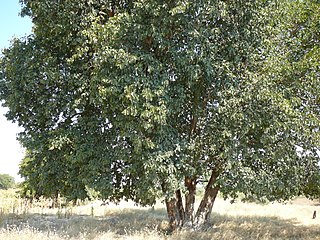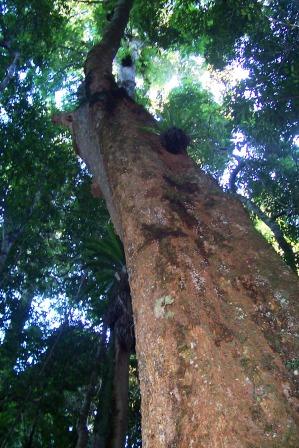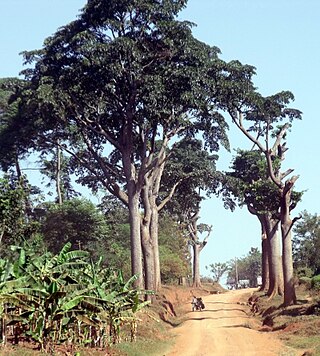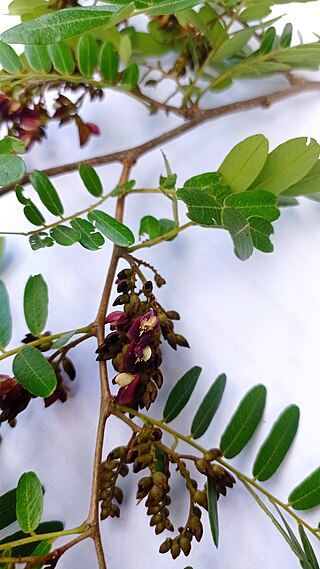
Pterocarpus is a pantropical genus of trees in the family Fabaceae. It belongs to the subfamily Faboideae, and was recently assigned to the informal monophyletic Pterocarpus clade within the Dalbergieae. Most species of Pterocarpus yield valuable timber traded as padauk, usually pronounced or ; other common names are mukwa or narra. The west African species may be traded as African rosewood. P. santalinus also yields the most precious red sandalwood in China known as Zitan. The wood from the narra tree and the Burmese padauk tree is marketed as amboyna when it has grown in the burl form. The scientific name is Latinized Ancient Greek and means "wing fruit", referring to the unusual shape of the seed pods in this genus.

Dalbergia is a large genus of small to medium-size trees, shrubs and lianas in the pea family, Fabaceae, subfamily Faboideae. It was recently assigned to the informal monophyletic Dalbergia clade : the Dalbergieae. The genus has a wide distribution, native to the tropical regions of Central and South America, Africa, Madagascar and southern Asia.

Cocobolo is a tropical hardwood of Central American trees belonging to the genus Dalbergia. Only the heartwood of cocobolo is used; it is usually orange or reddish-brown, often with darker irregular traces weaving through the wood. The heartwood changes color after being cut and can be polished to a lustrous, glassy finish. Being quite dense and sometimes having a specific gravity of over 1.0, it will sink in water. The sapwood is a creamy yellow with a sharp boundary between it and the heartwood.

Brachystegia is a genus of tree of the subfamily Detarioideae that is native to tropical Africa.

Entandrophragma is a genus of eleven known species of deciduous trees in the family Meliaceae.

Rosewood is any of a number of richly hued hardwoods, often brownish with darker veining, but found in other colours. It is hard, tough, strong, and dense. True rosewoods come from trees of the genus Dalbergia, but other woods are often called rosewood. Rosewood takes a high polish and is used for luxury furniture-making, flooring, musical instruments, and turnery.

Peltogyne, commonly known as purpleheart, violet wood, amaranth and other local names is a genus of 23 species of flowering plants in the family Fabaceae; native to tropical rainforests of Central and South America; from Guerrero, Mexico, through Central America, and as far as south-eastern Brazil.
Tonewood refers to specific wood varieties used for woodwind or acoustic stringed instruments. The word implies that certain species exhibit qualities that enhance acoustic properties of the instruments, but other properties of the wood such as esthetics and availability have always been considered in the selection of wood for musical instruments. According to Mottola's Cyclopedic Dictionary of Lutherie Terms, tonewood is:
Wood that is used to make stringed musical instruments. The term is often used to indicate wood species that are suitable for stringed musical instruments and, by exclusion, those that are not. But the list of species generally considered to be tonewoods changes constantly and has changed constantly throughout history.

Baikiaea is a genus of flowering plants in the legume family, Fabaceae. It includes six species of trees native to sub-Saharan Africa. Species range from Nigeria eastwards to Uganda and Tanzania and south to Zimbabwe, Botswana, and Namibia. Habitats range from lowland tropical rain forest to seasonally dry forest and woodland or savannas on well-drained soils.

Baikiaea plurijuga, known as African teak, Mukusi, Rhodesian teak, Zambian teak or Zambesi redwood, is a species of Afrotropical tree from the legume family, the Fabaceae from southern Africa.
Guibourtia ehie is an evergreen tree of the genus Guibourtia in the family Fabaceae, also known by the common names amazique, amazoué, hyedua, black hyedua, mozambique, ovangkol and shedua.

Pericopsis elata is a species of flowering plant in the family Fabaceae and is known by the common names African teak, afromosia, afrormosia, kokrodua and assamela.
Guibourtia arnoldiana is a species of Guibourtia in the family Fabaceae, native to tropical western Africa from the Gabon, Republic of the Congo, western Democratic Republic of the Congo, and northernmost Angola (Cabinda).

Didymocheton fraserianus, commonly known as rosewood or rose mahogany, is a medium-sized to large tree native to New South Wales and Queensland. It is widely used with the purpose of street design and to provide shade in the eastern suburbs of Sydney. Rosewood ranges from the rainforest around eastern Australia from Bundaberg in Queensland to Wyong in New South Wales. At maturity, it can reach a height of 57 metres (200 ft). It is generally known for its strong scent of rose from its bark.

Iroko is a large hardwood tree from the west coast of tropical Africa that can live up to 500 years. This is the common name for the genus Milicia, in which there are two recognized species, which are closely related: Milicia excelsa and Milicia regia.
Dalbergia stevensonii, also called Honduras rosewood, is a Central American tree species in the legume family. It grows in broadleaf evergreen swamp forests in southern Belize and adjacent Guatemala and Mexico. The wood is highly valuable, which has led to population loss from illegal logging.
Daniellia oliveri is a species of tree in the family Fabaceae. It is native to tropical West and Central Africa and is commonly known as the African copaiba balsam tree, or the West African copal tree.
Guibourtia tessmannii is a species of legume in the family Fabaceae. It is a medium to large-sized tree and is native to Cameroon, Gabon and Equatorial Guinea. The timber has an attractive appearance and has many uses, and the bark is used in traditional medicine.

Machaerium scleroxylon is a species of tree in the family Fabaceae Common names for the species include: pau ferro, morado, caviuna, Bolivian rosewood, and Santos rosewood. The wood is used as an alternative species to genuine rosewoods belonging to the genus Dalbergia.













